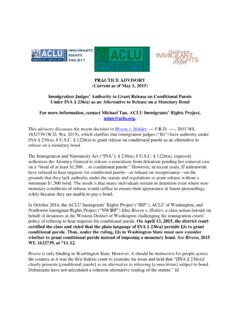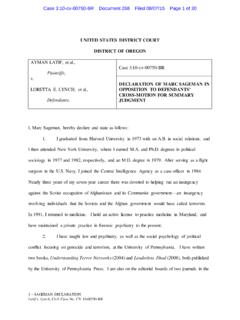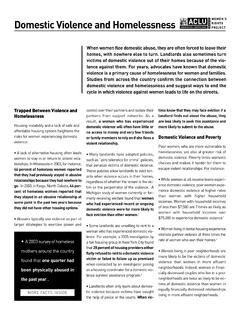Transcription of Policy 3()9 Medford Police Department
1 Policy Medford Police Department 3()9 Policy Manual TASER Guidelines PURPOSE AND SCOPE. The TASER device is intended to control a violent or potentially violent individual while minimizing the risk of serious injury. It is anticipated that the appropriate use of such a device will result in fewer serious injuries to officers and suspects. PROCEDURES: PRO Using TASERS. FORMS: FRM TASER Qualification Policy . Personnel who have completed Department -approved training may be issued the TASER. for use during their current assignment. Personnel leaving a particular assignment may be expected to return it to the Department 's inventory. Officers shall only use the TASER and cartridges that have been issued by the Department .
2 Uniformed officers who have been issued the TASER shall wear the device in an approved holster on their person. Non-uniformed officers may secure the TASER in the driver's compartment of their vehicle. If the TASER is carried as part of a uniformed officer's equipment, the TASER shall be carried on the side opposite the officer's duty weapon. (a) All TASERs shall be clearly and distinctly marked to differentiate them from the duty weapon and any other device. (b) Whenever practicable, officers should carry a total of two or more TASER cartridges on their person when carrying the TASER. (c) Officers shall be responsible for ensuring that their issued TASER is properly maintained and in good working order at all times.
3 (d) Officers should never hold both a firearm and the TASER at the same time. VERBAL AND VISUAL WARNINGS. A verbal warning of the intended use of the TASER should precede its application, unless it would otherwise endanger the safety of officers or when it is not practicable due to the circumstances. The purpose of the warning is for the following: (a) Provide the individual with a reasonable opportunity to voluntarily comply. (b) Provide other officers and individuals with a warning that a TASER may be deployed. If, after a verbal warning, an individual is unwilling to voluntarily comply with an officer's lawful orders and it appears both reasonable and practical under the circumstances, the officer may, but is not required to, display the electrical arc (provided there is not a cartridge loaded into the TASER) or the laser in a further attempt to gain compliance prior to the TASERTM Guidelines- 65.
4 Adopted: 2011/08/03 1995-2011 Lexipol, LLC. - 30157 - Medford Police Department Policy Manual TASER Guidelines application of the TASER. The aiming laser should never be intentionally directed into the eyes of another as it may permanently impair his/her vision. The fact that a verbal and/or other warning was given or reasons it was not given shall be documented by the officer deploying the TASER. USE OF THE TASER. As with any law enforcement equipment, the TASER has limitations and restrictions requiring consideration before its use. The TASER should only be used when its operator can safely approach the subject within the operational range of the TASER.
5 Although the TASER is generally effective in controlling most individuals, officers should be alert to the potential for failure and be prepared with other options. FACTORS TO DETERMINE REASONABLENESS OF FORCE. The application of the TASER is likely to cause intense, but momentary, pain. As such, officers should carefully consider and balance the totality of circumstances available prior to using the TASER including, but not limited to, the following factors: (a) The qonduct of the individual being confronted (as reasonably perceived by the officer at the time). (b) Officer/subject factors ( , age, size, relative strength, skill level, injury/exhaustion, number of officers vs.)
6 Subject(s). (c) Influence of drugs/alcohol (mental capacity). (d) Proximity of weapons. (e) The degree to which the subject has been effectively restrained and his/her ability to resist despite being restrained. (f) Time and circumstances permitting, the availability of other options (what resources are reasonably available to the officer under the circumstances). (g) Seriousness of the suspected offense or the reason for contact with the individual. (h) Training and experience of the officer. (i) Potential for injury to citizens, officers and suspects. U) Risk of escape. (k) Other exigent circumstances. APPLICATION OF THE TASER. Authorized personnel may use the TASER when circumstances known to the individual officer at the time indicate that such application of the TASER is reasonable to control a person in any of the following circumstances: (a) The subject is violent or physically resisting.
7 (b) A subject who, by words or action, has demonstrated an intention to be violent or to physically resist and who reasonably appears to present the potential to harm officers, him/herself or others. (c) Absent meeting the conditions set forth in (a) or (b) above, or a reasonable belief that an individual has committed or threatened to commit a serious offense, mere flight from pursuing officers shall not serve as good cause for the use of the TASER to apprehend an individual. TASER Guidelines- 66. Adopted: 2011/08/03 1995-2011 Lexipol, LLC. - 30158 - Medford Police Department Policy Manual TASER Guidelines When practicable, the officer should give a verbal warning of the intended use of the TASER.
8 Followed by a reasonable opportunity to voluntarily comply. The officer must be able to articulate a reasonable belief that other available options appeared ineffective, impractical or would have presented a greater danger to the officer, the subject or others. SPECIAL DEPLOYMENT CONSIDERATIONS. The use of the TASER should generally be avoided in the following situations unless the totality of the circumstances indicate that other available options reasonably appear ineffective, impractical, or would present a greater danger to the officer, the subject or others, and the officer reasonably believes that the need to control the individual outweighs the risk of using the TASER: (a) Pregnant females.
9 (b) Elderly individuals or obvious juveniles;. (c) Individuals who are handcuffed or otherwise restrained;. (d) Individuals who have been recently sprayed with a flammable chemical agent or who are otherwise in close proximity to any flammable material; or (e) Individuals whose position or activity may result in collateral injury ( falls from height, operating vehicles). Because the application of the TASER in the drive-stun mode ( direct contact without darts) relies primarily on pain compliance and requires close proximity to the subject, additional caution should be exercised. The application in drive-stun mode should be limited to brief applications in which pain compliance would reasonably appear necessary to achieve control.
10 The TASER shall not be used to torture, psychologically torment, elicit statements or to punish any individual. TARGETING CONSIDERATIONS. While manufacturers generally recommend that reasonable efforts should be made to target lower center mass and to avoid intentionally targeting the head, neck, chest and groin, it is recognized that the dynamics of each situation and officer safety may not permit the officer to limit the application of the TASER darts to a precise target area. As such, officers should take prompt and ongoing care to monitor the condition of the subject if one or more darts strikes the head, neck, chest or groin until he/she is released to the care of paramedics or other medical personnel.









